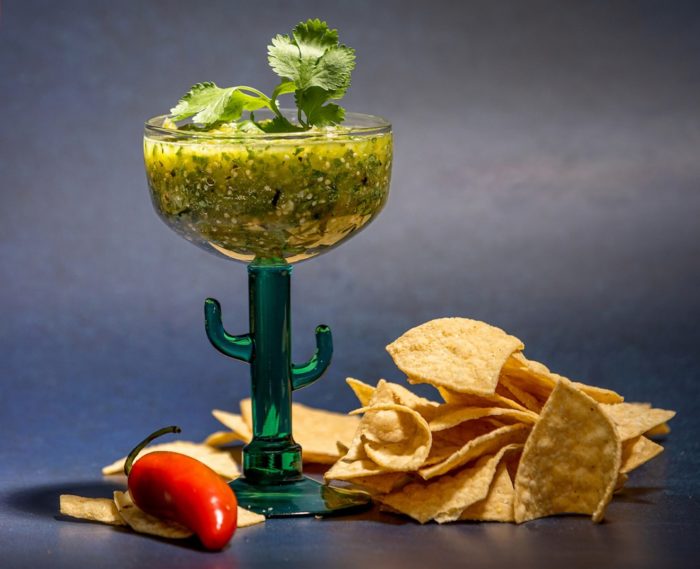A tomatillo (Physalis philadelphica) looks like a small green tomato covered with a pale green husk. The name tomatillo means “little tomato” in Spanish, and the fruit is indeed related to tomatoes, both being a part of the nightshade or Solanaceae family. They are close relatives of the Cape gooseberry (not a true gooseberry) and the Japanese Lantern fruit (bladder cherry).
They are often confused with actual green tomatoes, the unripe versions of regular tomatoes which they resemble. These two fruits are actually different species, although they are from the same botanical family. Green tomatoes are tomatoes that didn’t ripen by the end of the growing season. so, they are commonly seen in late summer and early autumn, which happens to be when tomatillos are in season as well.
Both have a tart, acidic flavor and firm, almost crunchy texture, and can be used in many of the same ways. The most obvious difference is that tomatillos have a husk on them and are much smaller than most green tomatoes.
Tomatillos are very popular and unique to Mexican and Southwest cooking. Curiously they haven’t found a place in other world cuisines like so many “new world” crops have like tomatoes, corn and peppers.
The fruit, generally 1.5 to 2 inches in diameter, ripens from a vivid green to a yellow color, but tomatillos are almost always used when green, when their unique flavor is at its height. Some varieties, however, are purplish or yellow in color.
Although the fruit looks like a little green tomato, the flesh is much firmer and has a tangy flavor all its own, with lemony and spicy herbal overtones. They are now widely available in the U.S. and available all year.
Tomatillos are easy to grow for you gardeners out there and, in the Southwest and Mexico grow wild. There are several varieties all of which are interchangeable in cooking:
Purple – This has a dark purple skin that adds color to the garden. It’s a lot sweeter than other green-colored tomatillos and makes a great snack fresh off the plant. Purple is equally delicious in salsa.
Purple Coban – Another purple-colored variety, this one is an heirloom. It matures in 70 days.
Toma Verde – This type is quick-maturing tomatillo (60 days) that produces relatively large sized fruits. It’s an excellent ingredient for any Mexican recipe.
Tomayo – This variety yields big green balls of semi-sweet tomatillos. Another excellent choice for salsa-making.
Amarylla – A yellow colored variety that matures in about 60 days. Amarylla is good for salsa but sweet enough for preserves.
Rio Grande Verde – For the gardener looking for a plant that yields big fruits, this variety is the number one choice. It yields tomatillos almost as big as apples!

Using Tomatillos
The husk, called a calyx, is easy to remove but leaves a sticky residue that needs to be washed off before the fruit is used.
Tomatillos are central to the flavor of salsa verde (with its many variations), and many other Mexican and Central American dishes. They can be used raw but they are often cooked. Cooking softens the texture and deepens the flavor of the fruit.
Buying Tomatillos
When you purchase tomatillos, the husk will probably be light brown and slightly opened. Make sure the fruit underneath is a uniform light green color with a firm texture. Avoid soft tomatillos unless you have a recipe that specifically calls for yellow, riper, fruit. Mexican cooks sometimes pull up entire plants and hang them upside down in a dry place, with the fruits still attached and can last for months.
Storage
If you need to store them, leave them in their husk and place them in a paper bag in the refrigerator for up to one month. They can also be frozen for long-term storage.
Other Names
In Mexico, the tomatillo is also known as milto-mate, tomate verde, tomate de milpa, fresadilla, or even just tomate. They are also called Mexican husk tomatoes and like many members of the genus Physalis, ground cherries. The tomatillo was probably more often consumed during ancient times than the sweet red tomato or jitomate and has been cultivated in Mexico since pre-Columbian times.

SOPA DE LIMA
(Mexican Chicken Soup with Lime and Tomatillos)
Serves 8
One of the classic dishes of the Yucatan, the tomatillos enhance the lime flavor.
Coconut or other vegetable oil for frying
3 6-inch yellow or white corn tortillas, cut into thin strips
1 whole chicken (about 3 pounds)
2 medium white onions, peeled, halved and sliced lengthwise
4 cloves garlic, thinly sliced
1 large poblano pepper, stemmed, seeded and diced
1 teaspoon ground cumin
2 teaspoons oregano, preferably Mexican
1 teaspoon fennel seed
2 teaspoons pure chile powder such as ancho or 1/2 teaspoon dried chile flakes
3 cups or so quartered tomatillos
2 cups cooked long-grain white rice, optional
Kosher salt and freshly ground pepper
5 large limes, 4 juiced and one cut into wedges for garnish
Additional garnishes: Sliced jalapeños, cilantro sprigs, avocado slices, crumbled cotija cheese, reserved tortilla strips
Line a plate with a paper towel. Add an inch of oil to a deep saucepan and over moderately high heat, fry the tortilla strips until crisp and golden brown, about 2 minutes. Using a spider or slotted spoon, transfer the tortilla strips to the towel-lined plate and let them cool.
Nestle the chicken in a large stock pot and pour enough water into the pot to cover the chicken by 2 inches. Bring the water to a gentle boil over medium-high heat and then immediately reduce the heat to medium-low, partially cover, and very gently simmer until the chicken is cooked through and the meat shreds easily with a fork, about 1-1/2 hours.
Remove the chicken from the pot and place on a plate to rest until it’s cool enough to handle. Remove and discard the skin. Pull the meat from the bone and shred it with a fork and set aside.
Strain the cooking liquid through a fine-mesh sieve, discarding the solids and set aside. Wipe out the pot, add 2 tablespoons of oil and over moderate heat, sauté the onions, garlic, poblano, cumin, oregano, fennel seed and chile until vegetables are softened, about 6 minutes. Add 6 cups or so of the stock, tomatillos, reserved chicken and simmer for 10 minutes more. Taste for seasoning and add salt, pepper, more chile powder and lime juice (at least 3 tablespoons) as needed.
Add a scoop of rice, if using, to warm bowls and ladle soup over. Pass garnishes, including fried tortilla strips, separately and allow each guest to add to their bowl as desired.
WILD MUSHROOM QUESADILLA WITH AVOCADO TOMATILLO SALSA
Makes 8 quesadillas
Quesadillas are quickly and easily made with all kinds of ingredients. When I have flavorful mushrooms, this is my favorite way to use them. You can also do this on the grill. Cultivated wild mushrooms like hen-of-the woods or portabella are my favorites with this recipe.
3 tablespoons butter
Olive oil
1-1/4 pounds wild mushrooms, cleaned and sliced thickly
2 teaspoons seeded and finely chopped serrano or jalapeno chiles, or to your taste
1/3 cup coarsely chopped cilantro leaves or a combination of mint and cilantro
Salt and freshly ground pepper
8 medium (10 inch or so) flour tortillas
12 ounces melting cheese such as Asadero, Oaxaca, Jack or a combination, grated
Avocado-Tomatillo Salsa (recipe follows)
Garnish: Sprigs of fresh cilantro
Preheat the oven to 225 degrees and place a sheet pan in it. Add butter to a large skillet along with a tablespoon of olive oil and over moderately high heat sauté the mushrooms and chiles until lightly browned and all juices have evaporated, about 8 minutes. Off heat, stir in the cilantro and season well with salt and pepper.
Wipe out the skillet and place over moderate heat. Lightly brush one side of each tortilla with olive oil and then one by one, place oiled side down in the skillet. Spread with a good 1/3 cup of cheese and then top with mushroom mixture on one half of the tortilla. In a minute or two the cheese will begin to melt and when it does fold the tortilla over the mushrooms and continue to cook on both sides until the tortilla is lightly browned and just beginning to crisp. Place the quesadilla on the pan in the oven to keep it warm and continue making the quesadillas in the same manner.
When all are done slice into wedges, top each wedge with the salsa, top with a cilantro sprig and serve immediately.
Avocado and Tomatillo Salsa
Makes about 1 cup
Typically, tomatillos are cooked when they are used in recipes. Cooking tones down their natural acidity and astringency. Here however, I’m using it raw where it’s a perfect foil for the buttery avocado. This salsa is also delicious on grilled meats and fish.
1/4 cup husked and chopped fresh tomatillos
1 teaspoon chopped garlic
1 teaspoon seeded and chopped fresh serrano chile, or to taste
1 tablespoon chopped scallion
2 large ripe avocados, peeled and pitted
Salt and freshly ground pepper to taste
In a food processor add the tomatillos, garlic and chile and pulse to finely chop. Coarsely chop the avocado, add to the processor and pulse until blended but still with a little texture. Season to taste with salt and pepper. Store covered and refrigerated for up to 2 days.
HUEVOS RANCHEROS VERDES
Serves 4
The Southwest’s favorite breakfast is often topped with a red sauce or salsa. This version has a tomatillo-based green (verde) sauce.
1/2 pound tomatillos, husked, rinsed
1 1/2 cups (packed) fresh cilantro leaves
3/4 cup diced peeled avocado
1/2 cup chopped onion
2 tablespoons fresh lime juice
4 teaspoons minced seeded serrano chilies
2 garlic cloves
1 teaspoon ground cumin
3 tablespoons (or more) butter
4 corn tortillas
8 large eggs
1 1/2 cups (packed) grated Monterey Jack cheese (about 6 ounces)
Cook tomatillos in large saucepan of simmering water until soft, about 20 minutes. Drain. Transfer tomatillos to blender; add 1 cup cilantro, avocado, onion, lime juice, chilies, garlic, and cumin; puree. Season with salt and pepper.
Melt 1 tablespoon butter in large nonstick skillet over medium-high heat. Add 2 tortillas; cook about 1 minute per side. Transfer to baking sheet. Repeat with remaining tortillas, adding more butter to skillet as necessary. Melt 1 tablespoon butter in same skillet over medium heat. Crack 4 eggs into skillet. Cover and cook eggs to desired doneness. Sprinkle fried eggs with salt and pepper. Using a spatula, place 2 eggs on each of 2 fried tortillas. Repeat with remaining eggs and 1 tablespoon butter. Top eggs on each tortilla with 1/4 of sauce and 1/4 of cheese. Using spatula, return 2 huevos rancheros to same skillet. Cover and cook over medium heat until cheese melts, about 3 minutes. Transfer to 2 plates. Repeat with remaining huevos rancheros. Sprinkle with 1/2 cup cilantro and serve.
TOMATILLO SALAD
Serves 6
This is a recipe passed on by Diana Kennedy. Born in England she, more than anyone, helped introduce the diversity of Mexican home cooking to American and British cooks. Among her 9 books was the 1972 breakout “The Cuisines of Mexico” which helped us all understand this delicious and varied cuisine. She was variously described as the Julia Child, the Escoffier, the high priestess of Mexican Cooking.
1-pound small tomatillos
2 serrano chiles or to taste, finely chopped
2 tablespoons finely chopped white onion
3/4 cup roughly chopped cilantro
3 tablespoons extra virgin olive oil
Kosher salt to taste
For the topping:
1/2 cup crumbled queso fresco or queso anejo
2 ounces Chicharrón, broken into small pieces
1 large firm, ripe avocado peeled, seeded and diced
Remove the husks from the tomatillos, rinse well and dry before chopping them coarsely. Mix in the rest of the ingredients. Just before serving top with the cheese, Chicharrón and avocado.

TOMATILLO SHAKSHUKA
Serves 4
Shakshuka, a Maghrebi (North African) dish, is very popular throughout that region, featuring poached eggs in a spicy tomato sauce, seasoned with peppers, onion, garlic, and various spices. It’s served throughout the day but mostly at breakfast. This version is made with tomatillos.
1 large poblano chile
1 to 2 serrano chiles, depending on your heat tolerance
1 tablespoon extra-virgin olive oil
1 medium yellow onion, diced
2 cloves garlic, minced
1 teaspoon ground cumin
1/2 teaspoon ground coriander
1/2 teaspoon sea or kosher salt, plus more for the eggs
2 pounds tomatillos, husk removed, washed and quartered
3/4 cup chicken stock or water
4 large eggs
1/2 cup crumbled feta or cotija cheese
1/2 cup finely chopped fresh cilantro
Heat the broiler to high. Line a baking sheet with aluminum foil. Cut peppers in half and discard seeds and stems. Place them on the foil lined sheet and broil until blackened on all sides, checking every 2 minutes and flipping them as needed. Transfer them to a heatproof bowl and cover tightly with plastic wrap. Let sit for 10 minutes then peel off the blackened skins from the chiles. Remove and discard the core and seeds. Pat the chiles dry and coarsely chop.
Heat the oil in a 10-inch, deep-sided skillet over medium heat until shimmering. Add the onion and cook, stirring frequently, until soft but barely browned, about 5 minutes. Stir in the chopped chiles, garlic, cumin, coriander, and salt, and cook for 2 minutes more.
Increase the heat to medium high. Add the tomatillos and water and cook, stirring frequently, until the tomatillos are completely broken down, 10 to 12 minutes, reducing the heat to medium as the tomatillos reduce and start to sputter.
Working with 1 egg at a time, crack it into a small bowl, then tip it into the sauce. Continue with the rest of the eggs. Sprinkle the eggs with salt. Cover and cook over medium heat just until egg whites are just set, about 8 minutes. Garnish with the feta and cilantro. Serve immediately.
All photographs by John Burgess of Santa Rosa Press Democrat.
John Ash © 9.23



